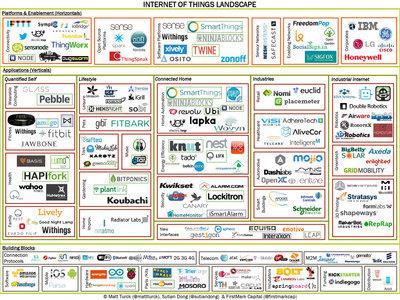by: Mirjam Visser, 2013-05-26 13:41:02 UTC
Sustainability Aspects: Optimizing demand and supply of for instance energy makes increases energy efficiency but also making production event pulled reduces waste.
The Story

In the coming years the Internet of Things will increasingly connect “intelligent” things, which themselves are represented by sub-systems according to Uckelmann’s definition.
These sub-systems will use the internet to communicate with each other — quite a recursive structure — fractal like living systems. Some estimates state that in less than ten years the Internet of Things will interconnect more than 50 billion such things: “Connecting me changes my life. Connecting everything changes everything … . All products and services that can benefit from connectivity will be connected. … We believe that by 2020 it is going to be 50 billion devices connected to the network” [Vestberg 2011]. Mark Weiser predicted the miniaturization of computation and the weaving of sensors into our daily life in his vision of “The Computer for the 21th Century” [Weiser 1999]. What he defined as “ubiquitous computing’” later became the “Internet of Things.”
In order to emphasize that this is not just about “things” and technology, but about “value” to the members of society, we use the term “Internet of Things & Services” (IoTS). Thinking of services purely as connectivity of things is far to narrow. Yes, “Everything will be connected to everything else,” but “no one has any idea what all those connections will mean” [Lucky 1999]. Meaning will be assigned at societal level as the fabric of society changes.Beyond the connectivity emerges the real potential.
Many different and now interconnectable domains offer themselves for applications:
- Health: tighter connections between physicians, hospitals, rescue centers, and patient supervision, prevention support by using modern technologies. Swallable modules can check internal health in hard to reach area’s. Implants and wearable devices can monitor health, administer drugs and connect patients to medical advisors.
- Mobility: a sophisticated charging infrastructure for electric vehicles, an intelligent system to orchestrate the related services, a new industry with connected vehicles, charging or mobility service providers, and utilities. Also individual mobility will be embedded in a wider multi-modal mobility framework connecting much better with public transport. Current examples are carsharing boxes that tell the provider fuel, services is needed to reduce wear.
- Production: taking the pull mechanism of lean production to the extreme, real-time decisions will derive from event-driven supply chains and diagnostics. Vending machines handling secure cashless payment and check inventory levels and functionality and act on it to order refill.
- Energy: Energy Management optimized to balance energy demand and consumption regionally and globally, at utilities, at industrial, at communal or at private consumers. Airconditioning is expensive and during heatwaves can increase risks of power cuts meaning it will fail when needed most. Ice Energy’s roof top Ice Bear units use cheap off peak energy at night to provide cooling during the day. They reduce peak consumption by up to 98% from 10,000 watts to 250 watts. The system communicates by Sim-card its data so in case of problems it can be diagnosed remote so problems can be fixed directly or an engineer can be dispatched.
Images

Internet of things Landscape

Internet of things Landscape
by Matt Turck, Sutian Dong and Firstmark Capital


Comments by our Users
Be the first to write a comment for this item.